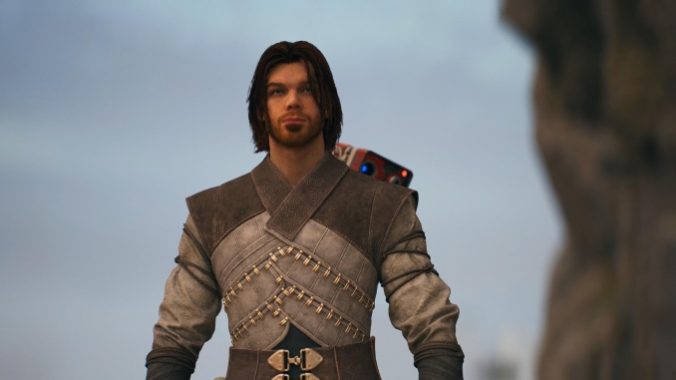We Made Our Star Wars Jedi: Survivor Character Look Like a Hair Metal Guy Trying to Go Alternative in 1993

I mean, that headline kind of says it all. Look at this guy: he looks like the bassist for Danger Danger or Trixter trying to survive in a post-Nevermind world. We accidentally stumbled across this look while playing around with the Star Wars Jedi: Survivor customization tools; they’re not the deepest or widest-ranging custom options ever seen in a videogame, or anything, but there’s still a lot of flexibility with your character’s clothes, hair style, and facial hair, and the latter two are especially fun to mess around with. It’s a small part of the game, but easily one of the most entertaining.
You’ll unlock new cuts and scruff for Cal Kestis across the galaxy while playing through the game, inexplicably finding beards and mullets in crates in dark caverns or hidden corners of Imperial bases, and can immediately equip them through the Jedi: Survivor customization menu. Most of them don’t fit the image of a Jedi in the slightest, although that’s somewhat in keeping with Cal’s backstory and his initial reluctance to embrace his Jedi past. At least half of them look absolutely ridiculous on Cal, but in a really fun and funny way. I forget where I got that ‘do Cal’s rocking in the photo below; I probably had to kill like a dozen droids to scrape it out of a box in a raider’s cave on Koboh. The game calls it a center part, but anybody alive in the ’90s knows the real name is a butt cut. (I actually styled my hair that way for maybe a week my first month in college. Yes, I was incredibly depressed.)

If you weren’t around when Nirvana’s Nevermind came out in 1991, you might not realize how distinct it was from the hard rock that MTV and the music industry had been pushing since the ’80s. Whether you want to call it metal, glam, cock rock, or hair metal (a term those bands generally do not like), groups like Mötley Crüe, Poison, Ratt, Dokken, Skid Row, and hundreds of interchangeable others dominated the mainstream rock scene from, say, 1983 until 1991, or so. You could recognize them before they even played a note, with long hair teased up high, usually bleached or permed, a dress code of spandex, scarves and leather, and often wearing makeup. It was a signal of the excess and hedonism those bands and their songs celebrated, and it was a fantasy that resonated hard with the young people of America throughout the ’80s.
At the same time there was a parallel music industry developing in the underground, across a national network of independent labels, small clubs, zines, alt weeklies, and college radio stations. By the end of the ’80s this system, developed piecemeal by punk and underground bands throughout the country—most crucially by Black Flag and the artists signed to their SST label (including Hüsker Dü, the Minutemen, the Meat Puppets, Sonic Youth, and many more)—was established enough where the circuit’s most popular bands could make a living through their music. One of the labels that launched during this moment was the Seattle-based Sub Pop, which by 1989 had become one of the more buzzed about indie labels after a string of releases by local hard rock bands, including Green River, Soundgarden, Mudhoney, and Nirvana. Although the songs these bands wrote weren’t all that similar, they were mostly all recorded by the same producer, Jack Endino, whose quick and cheap recording methods gave their albums a common sound that came to be called “grunge.” These Seattle bands were often inspired by some of the same classic rock and metal bands that influenced the hair metal scene, but beyond digging Sabbath and long hair, playing heavy, and doing some of the same drugs, they were two very different scenes. Nirvana especially was an antithesis to the party mentality of the hair metal bands, with frontman Kurt Cobain disgusted by the misogyny, homophobia, and over-the-top machismo that defined those bands. (People didn’t use the term “toxic masculinity” in the ’80s but it totally would’ve described the metal scene back then, even with so many of them dressing androgynously.) Nirvana did not look, sound, think, or talk like the biggest rock bands of the late ’80s, so when they blew up on the mainstream stage with their 1991 album Nevermind they had a seismic impact upon the culture. By the end of 1992 record labels had purged their rosters of lower-tier hair metal bands and begun a frantic search for the “next Nirvana” by signing almost any band that had a college radio hit; they lumped all of this, as well as major acts from the ’80s like U2, R.E.M., and The Cure, into a new radio format they called “alternative.” The biggest hair bands, like Crüe and Bon Jovi, didn’t disappear, but were noticeably less successful than they had been in the ’80s; the lesser bands either broke up or took drastic measures to stay afloat in this new cultural moment. And so, to keep up with the times and try to fit into the alternative format that (along with the rise of rap and hip-hop) had basically supplanted metal and hard rock as the center of mainstream music, so many of the dudes from those hair bands entered their own real life version of the Jedi: Survivor customization tools and cut their hair, grew goatees and soul patches, and tried to look like sad, serious men in their band photos instead of the coked-up sex pests they looked like (and often were) just a few years earlier.
That’s totally what my Cal Kestis looks like! (Yes, I’m still writing about a videogame, here.)